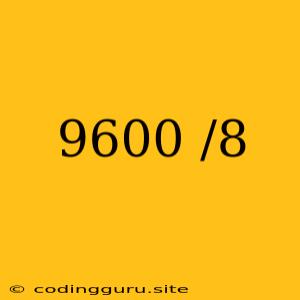Understanding Baud Rate: 9600 / 8
In the realm of digital communication, baud rate is a fundamental concept that defines the speed at which data is transmitted over a communication channel. It represents the number of signal changes (transitions) that occur per second. One common baud rate used in various applications is 9600.
What does 9600 / 8 mean?
The notation "9600 / 8" specifically refers to a serial communication configuration. It breaks down as follows:
- 9600: This is the baud rate itself, indicating 9600 signal changes per second.
- 8: This represents the number of data bits used to represent each character. In this case, each character is encoded using 8 bits.
Why is understanding 9600 / 8 important?
When establishing a serial communication link, you must ensure that both the sending and receiving devices are configured to use the same baud rate and data bit settings. If these settings are not compatible, the communication will fail. This mismatch can result in garbled data, errors, and the inability to establish a successful connection.
How is 9600 / 8 used in practice?
The 9600 / 8 configuration is prevalent in various communication protocols, including:
- RS-232: This is a common standard for serial communication over short distances, often used for connecting devices like modems, printers, and microcontroller boards to computers.
- RS-485: This standard enables multi-point communication, allowing multiple devices to share the same communication channel.
- UART (Universal Asynchronous Receiver/Transmitter): A widely used hardware component within microcontrollers and other embedded systems for serial communication.
What are the implications of using 9600 / 8?
- Data Transfer Rate: The baud rate directly affects the speed at which data is transmitted. A higher baud rate allows for faster data transfer. 9600 baud is considered a relatively slow speed by today's standards.
- Data Integrity: The number of data bits per character influences the amount of data that can be transferred per signal change. With 8 data bits, each character can represent a wider range of values.
Practical Considerations:
- Cable Length and Noise: In practice, the maximum reliable data transfer rate achievable with a specific baud rate is influenced by factors like cable length and noise levels. Longer cables and high noise levels can interfere with signal integrity, limiting the achievable baud rate.
- Compatibility: When communicating between different devices, ensure that they support the same baud rate and other serial communication settings like data bits, parity, and stop bits.
- Modern Alternatives: While 9600 baud is still relevant in some legacy applications, modern communication protocols often use faster speeds like 115200 baud or even higher.
In conclusion:
Understanding the meaning of 9600 / 8 is crucial for establishing reliable serial communication. It ensures proper configuration and compatibility between devices. However, with the advent of faster technologies, other communication methods and protocols often offer greater data transfer rates and capabilities.
